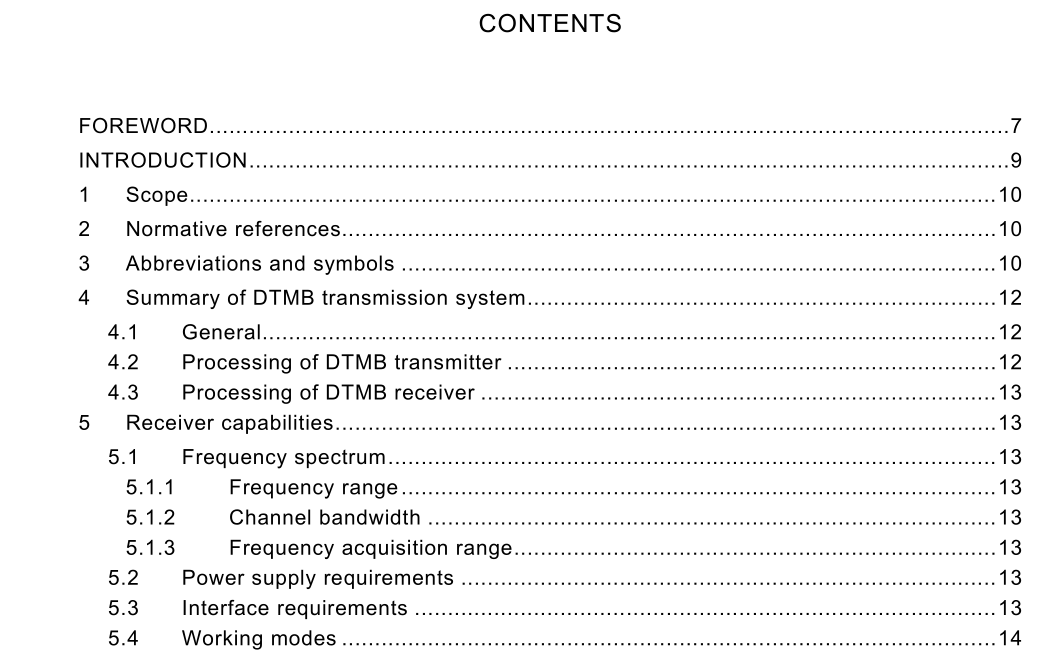IEC 62753 pdf download.Digital terrestrial television receivers for the DTMB system
1 Scope
This International Standard specifies the basic functions, interfaces, performance requirements and test methods of the receivers for the Digital Terrestrial/Television Multimedia Broadcasting (DTMB) system. This standard can be applied to digital television terrestrial receivers carrying multiple SDTV programs or HDTV programs for both mobile and stationary receptions.
2 Normative references
The following documents, in whole or in part, are normatively referenced in this document and are indispensable for its application. For dated references, only the edition cited applies. For undated references, the latest edition of the referenced document (including any amendments) applies. IEC 61 937-1 2, Digital audio –Interface for non-linear PCM encoded audio bitstreams applying IEC 60958 – Part 12: Non-linear PCM bitstreams according to the DRA formats ISO/IEC 1 381 8-1 , Information technology – Generic coding of moving pictures and associated audio information: Systems ISO/IEC 1 381 8-2, Information technology – Generic coding of moving pictures and associated audio information: Video ISO/IEC 1 381 8-3, Information technology – Generic coding of moving pictures and associated audio information –Part 3: Audio ETSI ETR 1 54, Digital Video Broadcasting (DVB); Implementation guidelines for the use of MPEG-2 Systems, Video and Audio in satellite, cable and terrestrial broadcasting applications ETSI TS 1 02 366, Digital Audio Compression (AC-3, Enhanced AC-3) Standard
4 Summary of DTMB transmission system
4.1 General This part of IEC 62753 provides the overview of the DTMB transmission system, including transmitters and receivers. Normative characteristics and requirements are provided in detail in Clauses 5 to 8. 4.2 Processing of DTMB transmitter The digital television terrestrial broadcasting system is used to convert the input data stream to the output RF signal. The following baseband processing will be applied to the input data stream sequentially: • Scrambling Pseudo random binary sequence of 2 1 5-1 bit long is used to randomize the input MPEG-2 input data before the channel coding block. • FEC LDPC code is used as part of the FEC. There are three different LDPC coding rates: LDPC (7 493, 3 048), LDPC (7 493, 4 572), LDPC (7 493, 6 096). A BCH (762, 752) is concatenated outside the LDPC. • Constellation mapping The output binary sequence of FEC is converted to MQAM symbol stream. DTMB supports the following constellations: 64QAM, 32QAM, 1 6QAM, 4QAM, and 4QAM-NR. • Interleaving A convolutional interleaver is utilized across many OFDM signal frames. • Multiplex of basic data block and system information Each frame body consists of 36 TPS symbols and 3 744 data symbols. The total length of FB is 3 780 symbols. • Combine the frame body and frame header to build the signal frame Each signal frame consists of frame header and frame body. The baseband symbol rate is 7,56 Msymbol/s. There are three different frame header lengths of 420, 595 and 945 symbols (with the relative guard interval length of 1 /9, 1 /6, and 1 /4). • Baseband processing Squared root raised cosine filter with 0,05 roll-off factor is adopted to shape the baseband signal and limit the bandwidth to 8 MHz. After these processings, the baseband signal will be up-converted to an RF signal in UHF or VHF band.4.3 Processing of DTMB receiver A digital terrestrial television receiver completes the conversion from RF input signal to audio output and video display. First, RF input signal is demodulated to TS. The TS is demultiplexed by demultiplexing module with SI/PSI and EPG information. Then, the elementary stream is decoded by the audio/video decoding module. Finally, the audio and video signals are transported to speakers and screens. The diagram of DTMB receiver processing is shown in Figure 2.
5 Receiver capabilities
5.1 Frequency spectrum 5.1 .1 Frequency range The receiver shall be able to receive all TV channels in the VHF and UHF bands. 5.1 .2 Channel bandwidth Channel bandwidth is 8 MHz. Effective bandwidth is 7,56 MHz. Occupied bandwidth of each channel is 7,56 × (1 + α)=7,938 MHz (α = 0,05). 5.1 .3 Frequency acquisition range The receiver shall be able to receive RF signal with frequency offset no more than ±1 50 kHz. 5.2 Power supply requirements Power supply requirements are shown in Table 1 .
IEC 62753 pdf download
